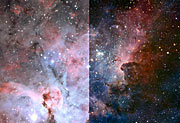Comunicato Stampa
Il VLT scatta la più dettagliata fotografia della Nebulosa Carena
08 Febbraio 2012
Il VLT (Very Large Telescope) dell'ESO ha prodotto la più dettagliata immagine del vivaio stellare noto come Nebulosa Carena mai ottenuta nella banda infrarossa. Molte strutture prima nascoste sono state svelate su questo sfondo celeste spettacolare di gas giovani stelle e polvere. Questa è una delle più spettacolari immagini mai create dal VLT.
Nel cuore della zona australe della Via Lattea si trova un vivaio stellare che va sotto il nome di Nebulosa Carena. Si trova a circa 7500 anni luce dalla Terra nella costellazione della Carena [1]. Questa nube di gas incandescente e di polvere è una delle più vicine incubatrici di stelle massicce e contiene molte delle più grandi e brillanti stelle note. Una di queste, la misteriosa e instabile Eta Carinae, fu la seconda stella più luminosa nel cielo per parecchi anni nel decennio del 1840 e probabilmente esploderà come supernova in un futuro non lontano, su scale astronomiche ovviamente. La Nebulosa Carena è un laboratorio ideale per gli astronomi che vogliono studiare la nascita violenta e l'infanzia delle stelle.
Anche se questa nebulosa risulta spettacolare in luce visibile (eso0905), molti dei suoi segreti si nascondono dietro spessi veli di polvere. Per penetrarli, un gruppo di astronomi europei, guidato da Thomas Preibisch (University Observatory, Munich, Germania) ha utilizzato le capacità del VLT (Very Large Telescope) dell'ESO in combinazione con una camera sensibile all'infrarosso chiamata HAWK-I [2].
Centinaia di singole immagini sono state combinate per creare questa foto finale, il mosaico infrarosso della nebulosa più dettagliato che sia mai stato realizzato e una delle più spettacolari immagini mai create dal VLT. Mostra non solo le stelle massicce più luminose, ma anche centinaia di migliaia di stelle più deboli [3] che prima non erano visibili.
La stessa abbagliante Eta Carinae appare in basso a sinistra in questa nuova immagine, circondata da nubi di gas che risplendono, incandescenti, sotto il feroce assalto della radiazione ultravioletta. In tutta l'immagine ci sono anche zone scure di materiale denso e compatto che rimane opaco anche nella banda infrarossa: sono i gusci di polvere che avvolgono le nuove stelle in formazione.
Nel corso degli ultimi milioni di anni, in questa regione celeste si sono formate molte nuove stelle, sia singole che in ammasso. L'ammasso brillante vicino al centro dell'immagine è Trumpler 14. Anche se compare nelle immagini nella banda visibile, un numero molto maggiore di stelle più deboli è evidente in questa vista all'infrarosso. Sulla sinistra invece si nota una piccola concentrazione di stelle che appare di color giallo. Questo raggruppamento di stelle è stato visto per la prima volta in questi nuovi dati del VLT: queste stelle non sono per nulla visibili nella banda della luce visibile. Questo è solo uno dei tanti nuovi oggetti appena svelati in questo panorama spettracolare.
Note
[1] La Carena è la chiglia della nave mitologica Argo, famosa per Giasone e gli Argonauti.
[2] Regioni di spazio piene di polvere assorbono e diffondono la luce blu, di lunghezza d'onda minore, molto di più della luce rossa, di lunghezza d'onda maggiore. Questo effetto spiega anche perchè i tramonti sulla Terra sono spesso rossi, soprattutto quando l'atmosfera contiene molta polvere. In alcune zone del cielo, in particolare nelle regioni di formazione stellare molto "polverose" come la Nebulosa Carena, questo effetto è così accentuato che la luce visibile non riesce a penetrare per nulla. Gli astronomi superano questo problema utilizzando la luce infrarossa osservata con strumenti speciali come HAWK-I sul VLT dell'ESO o con il telescopio infrarosso per survey VISTA.
[3] Uno degli scopi principali degli astronomi era di cercare in questa regione stelle più deboli e meno massicce del Sole. Questa immagine è anche abbastanza profonda per individuare giovani nane brune.
Ulteriori Informazioni
Nel 2012 cade il 50o anniversario della fondazione dell'ESO (European Southern Observatory, o Osservatorio Australe Europeo). L'ESO è la principale organizzazione intergovernativa di Astronomia in Europa e l'osservatorio astronomico più produttivo al mondo. È sostenuto da 15 paesi: Austria, Belgio, Brasile, Danimarca, Finlandia, Francia, Germania, Gran Bretagna, Italia, Olanda, Portogallo, Repubblica Ceca, Spagna, Svezia, e Svizzera. L'ESO svolge un ambizioso programma che si concentra sulla progettazione, costruzione e gestione di potenti strumenti astronomici da terra che consentano agli astronomi di realizzare importanti scoperte scientifiche. L'ESO ha anche un ruolo di punta nel promuovere e organizzare la cooperazione nella ricerca astronomica. L'ESO gestisce tre siti osservativi unici al mondo in Cile: La Silla, Paranal e Chajnantor. Sul Paranal, l'ESO gestisce il Very Large Telescope, osservatorio astronomico d'avanguardia nella banda visibile e due telescopi per survey. VISTA, il più grande telescopio per survey al mondo, lavora nella banda infrarossa mentre il VST (VLT Survey Telescope) è il più grande telescopio progettato appositamente per produrre survey del cielo in luce visibile. L'ESO è il partner europeo di un telescopio astronomico di concetto rivoluzionario, ALMA, il più grande progetto astronomico esistente. L'ESO al momento sta progettando l'European Extremely Large Telescope o E-ELT (significa Telescopio Europeo Estremamente Grande), della classe dei 40 metri, che opera nell'ottico e infrarosso vicino e che diventerà "il più grande occhio del mondo rivolto al cielo".
Links
- Articolo scientifico che descrive la osservazioni infrarosse della Nebulosa Carena
- La pagina web di Thomas Preibisch sulla Carena
- Osservazioni della Nebulosa Carena con APEX/LABOCA
- Osservazioni dela stessa regione di cielo in raggi X dal progetto Carena del telescopio Chandra
- Immagini del VLT
Contatti
Thomas Preibisch
University Observatory Munich/Ludwig-Maximilians-University
Munich, Germany
Tel.: +49 89 2180 6016
E-mail: preibisch@usm.uni-muenchen.de
Richard Hook
ESO, La Silla, Paranal, E-ELT and Survey Telescopes Public Information Officer
Garching bei München, Germany
Tel.: +49 89 3200 6655
Cell.: +49 151 1537 3591
E-mail: rhook@eso.org
Anna Wolter (press contact Italia)
Rete di divulgazione scientifica dell'ESO
e INAF-Osservatorio Astronomico di Brera
Milano, Italy
Tel.: +39 02 72320321
E-mail: eson-italy@eso.org
Sul Comunicato Stampa
| Comunicato Stampa N": | eso1208it |
| Nome: | Carina Nebula, NGC 3372 |
| Tipo: | Milky Way : Nebula : Type : Star Formation |
| Facility: | Very Large Telescope |
| Instruments: | HAWK-I |
| Science data: | 2011A&A...530A..34P |
Our use of Cookies
We use cookies that are essential for accessing our websites and using our services. We also use cookies to analyse, measure and improve our websites’ performance, to enable content sharing via social media and to display media content hosted on third-party platforms.
ESO Cookies Policy
The European Organisation for Astronomical Research in the Southern Hemisphere (ESO) is the pre-eminent intergovernmental science and technology organisation in astronomy. It carries out an ambitious programme focused on the design, construction and operation of powerful ground-based observing facilities for astronomy.
This Cookies Policy is intended to provide clarity by outlining the cookies used on the ESO public websites, their functions, the options you have for controlling them, and the ways you can contact us for additional details.
What are cookies?
Cookies are small pieces of data stored on your device by websites you visit. They serve various purposes, such as remembering login credentials and preferences and enhance your browsing experience.
Categories of cookies we use
Essential cookies (always active): These cookies are strictly necessary for the proper functioning of our website. Without these cookies, the website cannot operate correctly, and certain services, such as logging in or accessing secure areas, may not be available; because they are essential for the website’s operation, they cannot be disabled.
Functional Cookies: These cookies enhance your browsing experience by enabling additional features and personalization, such as remembering your preferences and settings. While not strictly necessary for the website to function, they improve usability and convenience; these cookies are only placed if you provide your consent.
Analytics cookies: These cookies collect information about how visitors interact with our website, such as which pages are visited most often and how users navigate the site. This data helps us improve website performance, optimize content, and enhance the user experience; these cookies are only placed if you provide your consent. We use the following analytics cookies.
Matomo Cookies:
This website uses Matomo (formerly Piwik), an open source software which enables the statistical analysis of website visits. Matomo uses cookies (text files) which are saved on your computer and which allow us to analyze how you use our website. The website user information generated by the cookies will only be saved on the servers of our IT Department. We use this information to analyze www.eso.org visits and to prepare reports on website activities. These data will not be disclosed to third parties.
On behalf of ESO, Matomo will use this information for the purpose of evaluating your use of the website, compiling reports on website activity and providing other services relating to website activity and internet usage.
Matomo cookies settings:
Additional Third-party cookies on ESO websites: some of our pages display content from external providers, e.g. YouTube.
Such third-party services are outside of ESO control and may, at any time, change their terms of service, use of cookies, etc.
YouTube: Some videos on the ESO website are embedded from ESO’s official YouTube channel. We have enabled YouTube’s privacy-enhanced mode, meaning that no cookies are set unless the user actively clicks on the video to play it. Additionally, in this mode, YouTube does not store any personally identifiable cookie data for embedded video playbacks. For more details, please refer to YouTube’s embedding videos information page.
Cookies can also be classified based on the following elements.
Regarding the domain, there are:
- First-party cookies, set by the website you are currently visiting. They are stored by the same domain that you are browsing and are used to enhance your experience on that site;
- Third-party cookies, set by a domain other than the one you are currently visiting.
As for their duration, cookies can be:
- Browser-session cookies, which are deleted when the user closes the browser;
- Stored cookies, which stay on the user's device for a predetermined period of time.
How to manage cookies
Cookie settings: You can modify your cookie choices for the ESO webpages at any time by clicking on the link Cookie settings at the bottom of any page.
In your browser: If you wish to delete cookies or instruct your browser to delete or block cookies by default, please visit the help pages of your browser:
Please be aware that if you delete or decline cookies, certain functionalities of our website may be not be available and your browsing experience may be affected.
You can set most browsers to prevent any cookies being placed on your device, but you may then have to manually adjust some preferences every time you visit a site/page. And some services and functionalities may not work properly at all (e.g. profile logging-in, shop check out).
Updates to the ESO Cookies Policy
The ESO Cookies Policy may be subject to future updates, which will be made available on this page.
Additional information
For any queries related to cookies, please contact: pdprATesoDOTorg.
As ESO public webpages are managed by our Department of Communication, your questions will be dealt with the support of the said Department.









